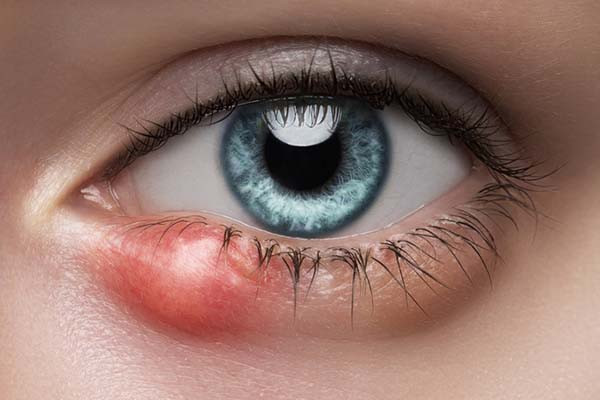What are the symptoms of a stye?
A stye (or hordeolum) is a common eye condition that typically affects the eyelid. The symptoms of a stye include:
Local Symptoms
- Redness: The affected area of the eyelid becomes red and inflamed.
- Swelling: A swollen, tender lump appears on the eyelid, which may be near the edge of the eyelid or inside the eyelid.
- Pain: The area around the stye can be painful or sensitive to touch.
- Tenderness: The stye is often tender when touched or pressed.
Other Symptoms
- Warm Sensation: The affected area might feel warm to the touch.
- Itching or Burning: Itching or a burning sensation in the eye or eyelid can occur.
- Tearing: Increased tear production or watery eyes can be a symptom.
- Crusting: The eyelid may develop a crust, particularly after sleep, due to discharge from the stye.
- Sensitivity to Light: Some people experience discomfort or sensitivity to light.
Possible Complications
- Discharge: The stye may eventually drain, releasing a small amount of pus.
- Conjunctivitis: In some cases, a stye can lead to conjunctivitis (pink eye), which involves inflammation of the lining of the eye and eyelid.
If a stye does not improve with home care, becomes increasingly painful, or affects vision, it’s important to seek medical attention.
What are the causes of a stye?
A stye (hordeolum) is caused by an infection of the oil glands in the eyelid. Here are the primary causes:
Bacterial Infection
- Staphylococcus Bacteria: The most common cause is a bacterial infection, often by Staphylococcus aureus, which infects the sebaceous glands or hair follicles in the eyelid.
Blocked Oil Gland
- Clogged Gland: A stye can develop when an oil gland in the eyelid becomes blocked. This blockage can lead to the buildup of oil and bacteria, resulting in an infection.
Poor Eyelid Hygiene
- Inadequate Cleaning: Not properly cleaning the eyelid area can lead to the accumulation of debris, oil, and bacteria, increasing the risk of infection.
Eye Irritation
- Irritants: Exposure to irritants or allergens, such as dust, smoke, or cosmetics, can contribute to inflammation and infection.
Existing Eye Conditions
- Blepharitis: Chronic inflammation of the eyelid margins (blepharitis) can increase the likelihood of developing a stye by causing the glands to become clogged and infected.
Touching the Eyes
- Frequent Touching: Touching or rubbing the eyes with unwashed hands can transfer bacteria to the eyelid, increasing the risk of developing a stye.
Pre-existing Skin Conditions
- Skin Conditions: Conditions like acne or dermatitis affecting the eyelid area can predispose individuals to styes.
Maintaining good eyelid hygiene, avoiding touching the eyes with dirty hands, and managing any existing skin conditions can help reduce the risk of developing a stye.
What is the treatment for a stye?
Treatment for a stye (hordeolum) typically focuses on relieving symptoms and promoting healing. Here are common treatment methods:
Home Care
- Warm Compresses: Apply a warm, moist cloth to the affected eyelid for 10-15 minutes, several times a day. This can help reduce swelling, ease pain, and promote drainage of the stye.
- Eyelid Hygiene: Keep the eyelid area clean by gently washing it with a mild soap or baby shampoo and water. Avoid using makeup or contact lenses until the stye heals.
- Avoid Squeezing: Do not attempt to squeeze or pop the stye, as this can spread the infection.
Over-the-Counter Treatments
- Antibiotic Ointments: If recommended by a healthcare provider, over-the-counter antibiotic ointments or drops may be used to prevent or treat bacterial infections.
Medical Treatments
- Prescription Medications: For more severe infections, a doctor may prescribe antibiotic ointments or oral antibiotics.
- Steroid Injections: In some cases, a healthcare provider may inject a corticosteroid to reduce inflammation if the stye is particularly large or persistent.
Professional Care
- Drainage: If the stye does not improve with home care or becomes increasingly painful, a healthcare provider may perform a minor procedure to drain the stye. This should be done by a professional to avoid complications.
Prevention
- Maintain Good Hygiene: Regularly clean the eyelids and avoid touching the eyes with dirty hands.
- Avoid Sharing Personal Items: Do not share towels, washcloths, or eye makeup to prevent the spread of bacteria.
When to Seek Medical Attention
- Persistent or Severe Symptoms: If the stye does not improve with home treatment, causes significant discomfort, affects vision, or is accompanied by severe swelling or redness, consult a healthcare provider.
Most styes improve on their own with proper care within a week or two. Following good hygiene practices and using warm compresses can help speed up recovery and alleviate symptoms.

Leave a Reply
You must be logged in to post a comment.